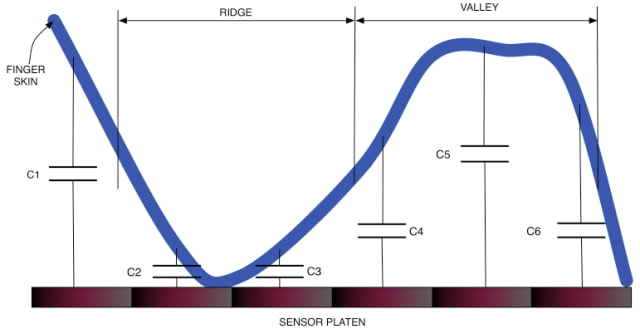There has been a lot of compelling evidence that hints at the next iPhone (iPhone 5S) featuring a fingerprint sensor. Today, biometric expert Geppy Parziale (who has over 15+ years of experience) has written an article describing how a fingerprint sensor on the iPhone would work.
Parziale's in depth looks first takes a look at the technology that power minature fingerprint sensors. For the upcoming iPhone, Parziale believes Apple will use a touch based fingerprint sensor, compared to a touchless sensor, which Geppy pioneered. While touchless fingerprint sensors produce a rich image, they are difficult to manufacturer and are not suitable for cell phones. However, touch-based sensors (which Apple will most likely use) have many technological issues that could make the sensor almost a gimmick.
Constant usage of the sensor starts to destroy the capacitors and over time, the fingerprint sensor stops to work. To avoid this issue, during the manufacturing process, the sensor surface is covered by insulating material (essentially silicon, processed to become an insulating layer) that protects the metallic surface. The touchscreen of your iPhone is manufactured in the same way. However, the coating layer on the fingerprint sensor surface cannot be too thick otherwise the electrons from your body cannot reach the metallic surface of the sensor to generate a fingerprint image. So, this protecting layer is thin and only used to extend the life of a sensor, but its continuous usage will destroy its surface, making the device useless.
In everyday life, things are even worst. You usually use your hands for different tasks and you usually touch different types of materials. Small portions of the objects you touch accumulate on the skin of your finger. When you touch the fingerprint sensor, you deposit these material on its surface. Additionally, your skin produces sweat (a combination of water and different types of salts) and the sebum (a oily/waxy substance our body produces). When you touch the surface of a fingerprint sensor, the mix of the sweat, sebum and any substance accumulate during your daily activities become a killer combination for the sensor surface that speeds up the destruction of its surface.
Gebby explains that fingerprint sensor manufactures rarely see success, including the one Apple recently acquired, Authentec, because of the poor durability of the sensors. Sensors in mobile devices like cell phones, and laptops often fail thanks to the poor sensor surfaces. The life of the sensor depends on many factors other than the quality, including where you live, how you use it, how careful you are with and even how clean your hands are.
Hopefully Apple's expertise in hardware will allow them to implement a well-built sensor that works well, but also lasts long enough for users.
Read More via 9to5mac


Parziale's in depth looks first takes a look at the technology that power minature fingerprint sensors. For the upcoming iPhone, Parziale believes Apple will use a touch based fingerprint sensor, compared to a touchless sensor, which Geppy pioneered. While touchless fingerprint sensors produce a rich image, they are difficult to manufacturer and are not suitable for cell phones. However, touch-based sensors (which Apple will most likely use) have many technological issues that could make the sensor almost a gimmick.
Constant usage of the sensor starts to destroy the capacitors and over time, the fingerprint sensor stops to work. To avoid this issue, during the manufacturing process, the sensor surface is covered by insulating material (essentially silicon, processed to become an insulating layer) that protects the metallic surface. The touchscreen of your iPhone is manufactured in the same way. However, the coating layer on the fingerprint sensor surface cannot be too thick otherwise the electrons from your body cannot reach the metallic surface of the sensor to generate a fingerprint image. So, this protecting layer is thin and only used to extend the life of a sensor, but its continuous usage will destroy its surface, making the device useless.
In everyday life, things are even worst. You usually use your hands for different tasks and you usually touch different types of materials. Small portions of the objects you touch accumulate on the skin of your finger. When you touch the fingerprint sensor, you deposit these material on its surface. Additionally, your skin produces sweat (a combination of water and different types of salts) and the sebum (a oily/waxy substance our body produces). When you touch the surface of a fingerprint sensor, the mix of the sweat, sebum and any substance accumulate during your daily activities become a killer combination for the sensor surface that speeds up the destruction of its surface.
Gebby explains that fingerprint sensor manufactures rarely see success, including the one Apple recently acquired, Authentec, because of the poor durability of the sensors. Sensors in mobile devices like cell phones, and laptops often fail thanks to the poor sensor surfaces. The life of the sensor depends on many factors other than the quality, including where you live, how you use it, how careful you are with and even how clean your hands are.
Hopefully Apple's expertise in hardware will allow them to implement a well-built sensor that works well, but also lasts long enough for users.
Read More via 9to5mac



